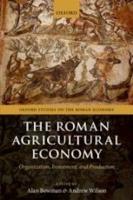
OUP (2018) p/b 333pp £27.50 (9780198788522)
This collection of papers draws together much recent research on a vital topic, namely how agriculture sustained the Roman Empire. The first chapter provides a literature review and a general survey of the topic. There then follow nine chapters on specific topics.
Dennis Kehoe examines the role of the state in agricultural production. On one view, agricultural systems and infrastructure develop to meet the needs of the current political regime, in this instance the Roman Empire. The alternative view is that population and technology are the principal drivers of economic change: social and political institutions are ‘epiphenomenal’, the by-products of economic conditions. The truth is somewhere between these two extremes.
Kehoe demonstrates that the relationship between institutions and economic change is a complex one. The Empire required the generation of massive agricultural surplus, to meet the needs of the army and to supply cities. The Empire survived for several centuries because that surplus existed. The Roman state was a large-scale landowner. It possessed vast estates in North Africa and elsewhere. The state also adopted legal and administrative policies which promoted agricultural production by private enterprise. Taxation rates were modest, perhaps in the region of 10%, with relief granted when harvests failed. By the 4th C tenant farmers, coloni, were obliged to stay for life on the same land. This reflected the Empire’s vital need for foodstuffs in a period when it was coming under increasing attacks. The state also had a role in facilitating long distance trade. The Roman authorities created the infrastructure, such as roads and harbours, which were essential for the transfer of agricultural produce over long distances.
The three main agricultural products of the Roman world were wine, olive oil and wheat (grain). Carriers normally transported wine and olive oil in amphorae, which leave an archaeological record. They transported wheat in sacks, which is less helpful for modern archaeologists. Two papers by Annalisa Marzano address wine and olive oil production in the hinterland of Rome (chapter 4) and in the provinces (chapter 5). The hinterland of Rome was densely occupied by modest farms and 338 villas. Some 44 of the villas had presses which could be used for producing wine or olive oil. Columella (1st C AD) records that the estate of Sthelenus, 16 kilometres from Rome, produced 40 hectolitres of wine per iugerum (about two thirds of an acre). This is evidence of very successful intensive grape cultivation. No amphora kilns have been found in the areas around Rome, but the Monte Testaccio was an artificial hill made of broken amphorae. Possibly these amphorae were imported. On reviewing all the available data, Marzano concludes that the hinterland of Rome generated a surplus of some 54 million litres of wine and some 4.7 million litres of olive oil for consumption in the metropolis per year.
Turning to the provinces, Marzano focuses on Gaul, Spain and the Black Sea region. Colonies founded by Caesar and Augustus in southern Gaul moved into wine production on a large scale. There are numerous multi-press sites, which must have been producing wine for export. The first and second centuries AD saw heavy investment in equipment and installations for wine production. Like much else in the Roman Empire, this industry went into decline in the third century. Olive oil production in Gaul was on a more modest scale and seemingly not for overseas export. The Iberian Peninsula was another major wine growing region. But that too suffered a decline in the third century. The story was similar in the Black Sea region.
A series of chapters follows on North Africa, which produced and exported grain on a large scale. The evidence here is both archaeological and papyrological. The papyri yield a wealth of detail about land use and productivity. Alan Bowman provides a helpful table in chapter 7, listing the fertile surface area for each of the Egyptian nomes (administrative regions). The lex Hadriana de rudibus agris encouraged investment in agriculture. Three copies of the lex have been found in imperial estates within modern Tunisia.
Chapter 9 by Myrto Malouta and Andrew Wilson describes mechanical irrigation and water wheels. The development of this technology explains why the population and wealth of the Empire were able to expand through the 1st and 2nd C AD, seemingly defying Malthusian principles. These new technologies brought previously barren land into agricultural production. Helpfully, ancient artists have provided pictures of some of the equipment for us. A mosaic in Tunisia shows a shaduf (swing beam with bucket and counterweight) in operation. A mosaic in Syria shows the design of a water wheel. A tomb painting in Alexandria shows oxen working a water-lifting wheel. Bucket-chain water-lifting technology reached Britain within twenty years of the conquest. Two square wells have been found in Gresham Street, London with the remains of water-lifting devices. One is dated c. AD 63, the other is early second century.
This is not a book for the casual reader. But it has much to offer anyone with a serious interest in how the Roman Empire managed to survive and to feed a growing population for several centuries. I commend the book to such readers.
Rupert Jackson
